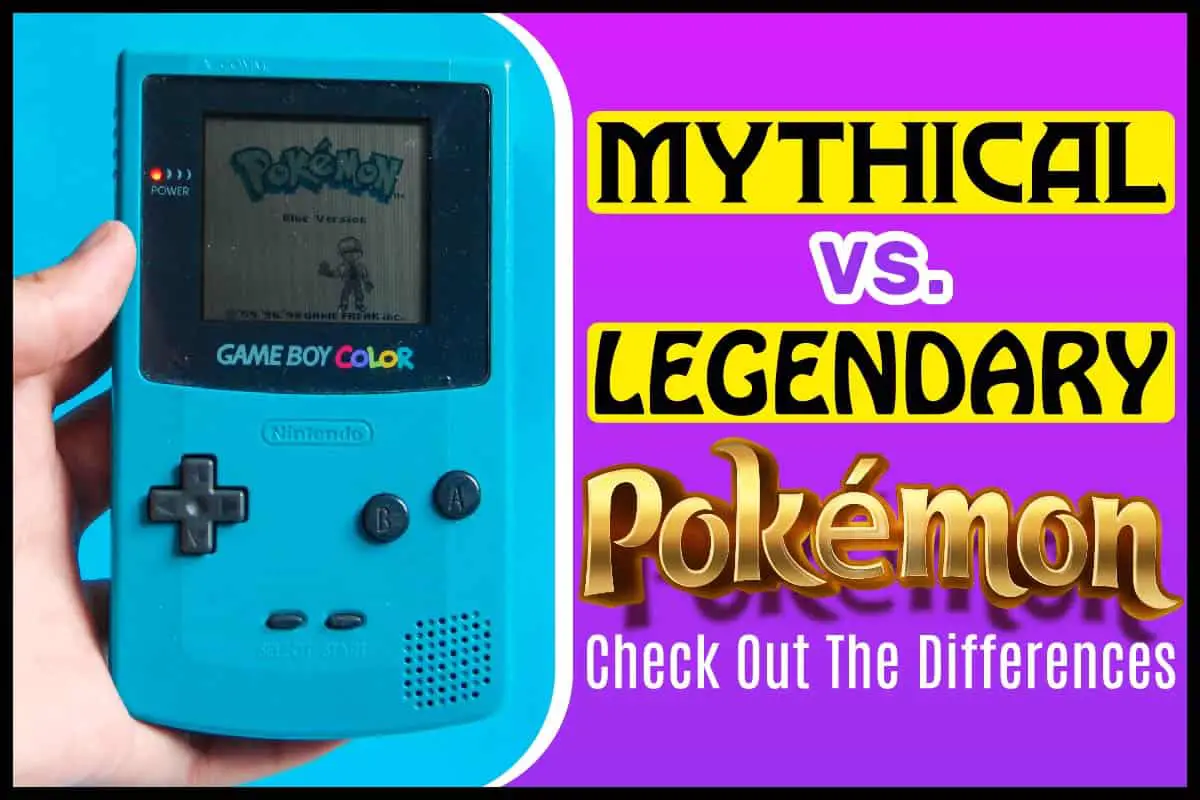Pokémon is a video game franchise created by Game Freak and released by Nintendo. Humans, known as Trainers, catch and train Pokémon to fight against other Pokémon.
The earliest Pokémon video games were released in 1998 for the Nintendo Game Boy, and the franchise has fuelled Pokémon’s popularity ever since.
Thus far, Pokémon games are only available on Nintendo platforms, such as the Nintendo 3DS and Wii U consoles.
Pokémon have been divided into two categories based on their rarity: Mythical and Legendary Pokémon. So, what’s the difference between these two?
Mythical Vs. Legendary Pokémon
Pokémon are creatures of various sizes and shapes that dwell in the wild or close proximity with humans.
Legendary and Mythical Pokémon creatures appear in every generation of the game. They are often the most powerful creatures that players can encounter.
One of the most considerable distinctions is that Mythical Pokémon is rarely encountered in ordinary gameplay in the core games.
Legendary Pokémon appear at various stages or the completion of the primary campaign. On the other hand, mythical Pokémon are usually unveiled months, if not years, after a game is launched.
Sometimes unveiling a Mythical Pokémon involved promotions that required players to do more than merely buying a copy of a game.
You may be required to see a specific theatrical Pokémon film, using a particular event item, or using the Mystery Gift function in recent editions.
An exception to this rule is Mew – the first mythical Pokémon introduced just before the initial Game Boy games were released.
Shigeki Morimoto, a game designer, created Mew and sneaked it into the original Pokémon Red and Green versions two weeks before being released in Japan.
Even Nintendo was unaware of this newly added species at first. Still, its popularity helped it become a famous character in the first generation of the Pokémon franchise, appearing in films, TV shows, and manga.
Other Differences
In terms of game creation, nothing extraordinary qualifies a species to be referred to as Legendary. Nintendo usually announces the distinction in the media or through marketing materials.
Legendary Pokémon have a unique set of gameplay characteristics. The gender of most Legendary Pokémon is unknown, although there are a few exceptions.
Also, Legendary Pokémon cannot breed or hatch from eggs, and a majority cannot evolve outside of their kind.
About Pokémon Creatures
The Pokémon series has grown and evolved since the initial 151 in the Game Boy editions. The series is set to commemorate its 25th anniversary next year.
Not only has this increased the total amount of pocket monsters available for players to capture, but it has also increased the variety of creatures players can encounter.
While the majority of kinds were released in the first generation games, others were added regularly.
New creatures are introduced to the list with each generation, ranging from the vintage creatures like Mew to the latest ones like Eternatus, Zacian, and Zamazenta featured in Sword and Shield.
Pokémon Universe
The game takes place in the fictional Pokémon universe. The series featured eight main areas – Johto, Kanto, Hoenn, Unova, Sinnoh, Alola Kalos, and Galar.
Each of the main series’ eight generations focuses on a different locale. Every area has several cities and towns that the player must visit to overcome various waiting difficulties like gyms, Contests, and malevolent teams.
The player can find several types of Pokémon and valuable goods and NPCs in various areas around each zone.
A player cannot access different areas within a single game. Johto and Kanto are exceptions as they are linked in some of the game series.
There are also spinoff games and two islands (Orange Islands and Decolore Islands) in the Pokémon anime, all of which are based in the same fictitious universe.
In the Pokémon universe, each main series area is based on a real-life location. The first four regions released (Kanto, Johto, Hoenn, and Sinnoh) are based on portions of Japan. Later areas are based on parts of the United States, France, and the United Kingdom.
Pokémon Gameplay
In most games, the player assumes the position of a young Trainer on a quest to become the Pokémon League Champion.
This quest involves traveling from place to place, capturing and training Pokémon, and competing against other Trainers’ Pokémon. Another objective is to capture and catalog all of the game’s Pokémon.
Pokémon gain experience and evolve into stronger beings as they progress through their adventures. The Pokémon universe now has over 700 different animals.
Even though the games involve battles, the Pokémon games do not contain explicit violence; Pokémon do not die throughout the game.
When playing, trainers are asked to participate in various extracurricular activities, such as talent and beauty contests, tournaments, and fishing.
Players can also battle and exchange Pokémon with other players, teaching kids the value of cooperation and sportsmanship. Players can now play and trade online with other Trainers worldwide with newer video game systems.
Pokémon are separated into distinct types, such as water and fire, each having its own set of abilities. The basic hand game rock-paper-scissors can be used to describe their battles.
A player might swap a water-based Pokémon to obtain an advantage over a Pokémon that can’t fight an opponent’s character due to a fire weakness.
Pokémon acquire strength and new skills as they get more experience. Trainers gain acclaim by fighting Gym Leaders and collecting Gym Badges.
History Of Pokémon
The original Japanese name for Pokémon was “Pocket Monsters.” Game Freak, founded by Ken Sugimori and Satoshi Tajiri in the early 1980s in Japan, was the inspiration for the franchise. Tajiri wrote the story, while Sugimori illustrated it.
The duo agreed that the arcade environment was no longer exciting and decided to create their games. Popular titles involved Nintendo games like Yoshi for the NES and Game Boy and SEGA games like Magical Tarurto-Kun for SEGA’s Mega Drive.
Game Freak used to have its games published by companies like Sony while it was still a developer. But Tajiri and his colleagues presented Nintendo with the concept of Pokémon.
Due to the popularity of Game Freak’s earlier releases, Tajiri was given the benefit of the doubt. This development birthed the second-largest gaming franchise in history.
The Pokémon franchise had its début in Japan on February 26, 1996, releasing both games for the Game Boy. Pocket Monsters: Red and Green was, at its core, a simple Japanese role-playing game. You play as a Pokémon trainer who travels the world collecting the ubiquitous creatures and training them in bouts against other Pokémon.
You start with a single Pokémon, and your goal is to catch all monsters. However, you had to trade with other players to obtain all 151 Pokémon.
Pokémon Red and Green were separate versions of the same game, and each included a few Pokémon that were only available in that game.
Players may join up and trade Pokémon and battle each other, using the Gameboy’s link cable.
The game’s other key feature was turn-based Pokémon battles. Tajiri had learned from playing The Final Fantasy Legend on the Game Boy that the system could handle more than just action games and that role-playing games had a place as well.
As a result, in Red and Green, you must go to several Pokémon gyms and battle gym leaders to earn badges, a procedure that becomes more difficult as you progress.
Finally, you’ll face up against some of the top Pokémon trainers in the land, as well as a villainous mega-corporation.
Nintendo sold millions of copies of Red and Green. The current hysteria over Pokémon Go on Android and iOS devices shows that the trading and collecting attitude to “100 percent completion” made the games more pleasant.
In the main series, the principle of two games, each release is still in place. Pokémon Sun and Moon is about to be launched in November.
More Pokémon emerged with each generation, eventually reaching 721 today (Sun and Moon will give us some more in November).
Mainstream Releases Of Pokémon Video Game
Pokémon’s major mainstream releases include the following:
- Pokémon Red and Green for Gameboy (a special Blue edition was released later)
- Pokémon Ruby and Sapphire for Gameboy Advance
- Pokémon Gold and Silver for Gameboy Colour
- Pokémon X and Y for Nintendo 3DS
- Pokémon Black and White for DS
- Pokémon Pearl for Nintendo DS
Pokémon Go
Pokémon Go is a mobile game that combines augmented reality (AR) with the main Pokémon gameplay. It is developed by Niantic and distributed by Nintendo. Nintendo and partners launched the game in 2016 for iOs and Android devices.
It uses GPS-enabled mobile devices to find, capture, train, and battle Pokémon that appear to be in the player’s actual location.
Conclusion
The Pokémon game involves human Trainers who catch and train Pokémon to fight against other Pokémon.
Pokémon are monsters of various sizes and shapes that dwell in the wild or close proximity to humans. Based on how difficult they are to find, Pokémon are either Legendary or Mythical.
Legendary and Mythical Pokémon creatures appear in every generation of the game. They are often the most powerful creatures that players can encounter.
Legendary Pokémon appear at various stages or after the primary campaign is completed, while Mythical Pokémon are usually unveiled months, if not years after a game is launched.
You May Like These Articles As Well:
Do Competitive Eaters Purge After?
How To Write An Absence Note For School- A Step By Step Guide
 Being Human
Being Human





